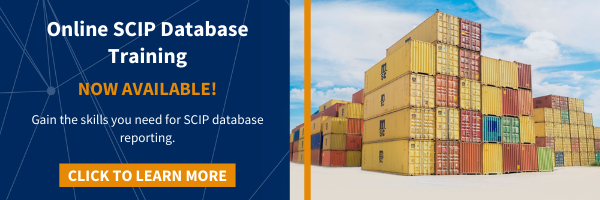Beginning in January 2021, many companies found themselves with a new compliance reporting obligation: the SCIP (Substances of Concern in Products) database. Tens of thousands of companies have successfully complied with their duties to notify the European Chemicals Agency of hazardous substances in products via SCIP, and the SCIP database contains millions of article notifications created by these companies. However, companies new to the EU market may still be trying to understand what their SCIP compliance requirements are.
What is the SCIP Database?
The SCIP database collects information on substances of concern in articles as such or in complex objects (products). It was established under the European Union’s Waste Framework Directive (WFD).
The SCIP database aims to increase knowledge of hazardous chemicals in articles and products throughout their whole lifecycle, including the waste stage. Reporting Substances of Very High Concern (SVHC) is required if those substances are present in articles at or above 0.1% concentration.
The first version of the SCIP database debuted on 28 October 2020, and companies were required to start reporting in SCIP by 5 January 2021.
What is the Purpose of SCIP?
The SCIP database is aimed at the elimination of SVHCs in articles sold in the European Union customs zone. It is intended to:
- Encourage industries to replace substances of concern in products and eliminate hazardous waste. This should provide some protections from hazardous materials to customers, downstream users, and waste operators.
- Assist enforcement authorities by making information on substances in articles available in their jurisdictions. This information can also provide a basis for new and improved legislation.
- Improve waste treatment options and help Europe implement its circular economy goals.
Do I Have SCIP Reporting Obligations?
Does your company produce, import, or supply products in the European Union? This is the most relevant question to determine your SCIP obligations. If you do, and if what you sell contains SVHCs, then you may have an obligation to report into the SCIP database.
If your products contain SVHCs, do any of them contain an SVHC at greater than 0.1% concentration? This is the second important question you must answer in order to understand your reporting obligations. To make this determination, you will need to collect information on all the components within all the products you export to the EU.
However, even if you don’t have a direct legal obligation to report to the SCIP database, you may still have requirements to meet. Some companies may have contractual obligations to provide relevant product information to their customers that operate in or import to the EU.

What Information Do I Need to Report in SCIP?
Information for articles and complex objects in your products must disclose where substances of concern are in the product and how they can be safely handled.
Information for articles within complex objects:
- Identifiers:
- Product name
- Brands
- A primary article identifier, such as the EAN, GTIN, catalogue number, or part number
- Categorization:
- CN or TARIC code
- Statement declaring if the article was produced in the EU or not
- Characteristics:
- Manufactured properties of the article (i.e., color, weight, etc.)
- Safe Use Instructions:
- Instructions for handling the article as in the Safety Data Sheets (SDSs)
Information for articles not in complex objects:
- SVHCs in the article
- Concentration of those SVHCs in the article
- Where the SVHCs are located within the article
- What the article is made of
To meet your SCIP compliance obligations, you must submit enough data about the articles and complex objects that a user would be able to identify substances of concern in the products and understand how to safety handle the products.
Getting Help with SCIP Compliance Reporting
If you are trying to understand your SCIP reporting requirements and how to get started, Tetra Tech can walk you through your reporting obligations and provide a SCIP action item plan you can use to remain compliant.
Some SCIP tasks Tetra Tech can help you with are:
- Determining the optimal set up of user roles and responsibilities for your organization.
- Manually submitting data and reports to SCIP using your own accounts.
- Automating reporting with electronic upload-download to and from the SCIP database.
- Serving as the role of “foreign user” within your SCIP account structure.
- Monitoring future SVHC reporting requirements.
If you need help with any of these tasks, contact Tetra Tech’s product compliance experts today at [email protected]. We can help you understand the changes in scope that will affect you and can support your SCIP compliance so you can focus on the day-to-day of running your business.






